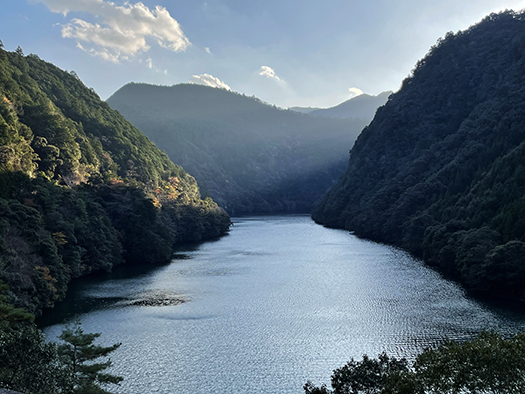

古事記という書物は、日本人と日本文化にとって基盤的な文献であるけれど、原文は漢文によって書かれているので、そのまま読むということは一般人には困難。
〜天地初発之時、於高天原成神名、天之御中主神。次高御産巣日神。次神産巣日神。此三柱神者、並独神成坐而、隠身也。〜っていうような書きだし。読み下し翻訳としては以下のようになる。〜天地初めて 発(ひら)けし時、高天の原に成れる神の名は、天之御中主神。次に高御産巣日神。次に神産巣日神。この三柱の神は、みな独神と成りまして身を隠したまひき。〜
そもそもの成立年代712年(和銅5)の当時には「ひらかな・カタカナ」も成立していない。そして漢字という東アジアでの表意文字を受容し始めた時期なので、悪戦苦闘しながら日本語自体も揺籃期にあった。原日本語は縄文期から連綿とつながってくる基盤が存在していただろうけれど、それでは律令のような「法体系」概念を翻訳コンニャクすることは不可能だった。そういう時代に、対中国王朝との国際関係形成という目的に沿って国史を編纂する必要性に迫られて、古事記は叡智を結集して創作された。
歴史好きであるのに、戦国動乱の血湧き肉躍る合戦展開主体に強く惹かれてのものだったわたしとしては、どうもよくわかんない、ということで敬して遠ざける存在だった。しかし、熊野や楯ヶ崎など探訪を重ねるようになって、完全にこころは古代ニッポンに飲み込まれてしまって(笑)、やはり古事記をアタマに入れていかなければと思うようになった次第です。
古事記については本居宣長による深掘りなど日本史上で連綿と行われてきたけれど、わたしとしてはやはり梅原猛先生の導きを最善と考えて、この書を読み進めた次第。
梅原猛先生は2019年に亡くなられた哲学者。国際日本文化研究センター名誉教授。法隆寺は怨霊を封じ込めた寺という独特の見解などの古代史研究で知られています。西田幾多郎先生の流れを汲む京都大学哲学の巨星。西洋哲学の解釈でいいと考える哲学探究学徒の主流に対して、日本というものを正面から見据えた歴史分析で広く知られている。
原・古事記の作者として柿ノ本人麻呂説を取られていることでも有名。
ということで先生のこの古事記著作を読了させていただき、いっそう古代史と日本語の創出について強い興味を掻き立てられているところであります。戦前期の皇国史観への反省から、その真逆のような津田左右吉の記紀否定の立場にながく呪縛され、国の教育体系でも不当に古事記を無視してきた日本古代史に対して、平明に受容できる視点で描かれている。
今後ともこの書と対話しながら、古代史を淡々と探究してみたいと思っています。
English version⬇
Read “Kojiki” under the guidance of Prof. Takeshi Umehara.
A plain analysis and guide to the Kojiki as a philosopher against the situation of ancient history research, which symbolizes Japan’s inability to escape from the spell of the postwar GHQ regime. …
The Kojiki is a fundamental document for the Japanese people and Japanese culture, but the original text is written in Chinese, making it difficult for the average person to read it verbatim.
〜When heaven and earth first arose, the name of the deity in Takamagahara was Amano-no-Mikazunushi. The name of the deity is Amano-no-Mikazunushi. The next is the deity Kaminosusuhi. These three deities are the only deities who are seated, and they are in hiding. 〜The translation reads as follows. The translation is as follows. 〜When heaven and earth were first created, the name of the deity that was formed in the field of the high heaven was Amano-no-Mikazunushi. Next, Takami-no-Mitsusuhi. Next, the deity Kaminosunnusuhi. These three deities all hid themselves in solitude. 〜The first three deities are
Hiragana and katakana were not even established in 712. The Japanese language itself was in its infancy as it struggled with the East Asian ideographs known as kanji. Although the original Japanese language may have been based on the Jomon period, it was impossible to translate the concept of a “legal system,” such as the Ritsuryo, into Japanese. In such an era, the Kojiki was created with all the wisdom of the time, driven by the need to compile a national history in line with the objective of forming international relations with the Chinese dynasties.
As a history buff, I was strongly attracted to the bloody battles of the Warring States period, but I avoided the book because I did not understand it well. However, as I have visited Kumano and Tategasaki more and more, my heart has been completely swallowed up by ancient Japan (laugh), and I have come to think that I must have the Kojiki in my mind.
Although the Kojiki has been studied in depth by Nobunaga Motoya and others throughout Japanese history, I decided to read this book with Takeshi Umehara’s guidance as my best bet.
Takeshi Umehara was a philosopher who passed away in 2019. He was a professor emeritus at the International Research Center for Japanese Studies. He is known for his research on ancient history, including his unique view that Horyuji Temple was a temple that contained grudge spirits. He was a giant of Kyoto University philosophy, following in the footsteps of Dr. Kitaro Nishida. He is widely known for his historical analysis that focuses squarely on Japan, as opposed to the mainstream of philosophical inquirers who think it is sufficient to interpret Western philosophy.
He is also famous for his theory that Kakino Honmaro is the author of the original Kojiki.
Having read his work on Kojiki, I have become even more interested in ancient history and the creation of the Japanese language. The book presents a clear and acceptable perspective on ancient Japanese history, which has been unfairly neglected in the national educational system.
I would like to continue to explore ancient history in a straightforward manner while interacting with this book.
Posted on 4月 6th, 2024 by 三木 奎吾
Filed under: 歴史探訪







コメントを投稿
「※誹謗中傷や、悪意のある書き込み、営利目的などのコメントを防ぐために、投稿された全てのコメントは一時的に保留されますのでご了承ください。」
You must be logged in to post a comment.